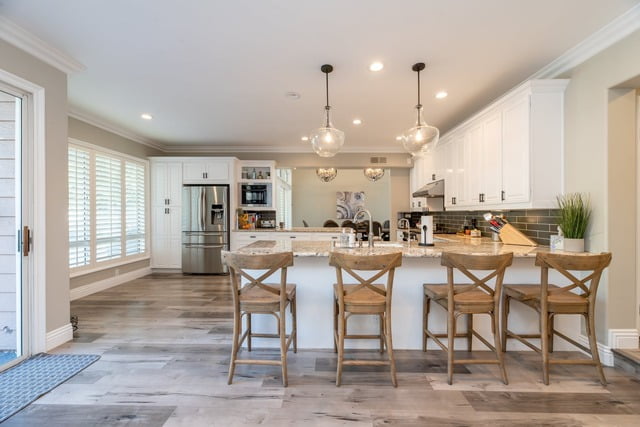What do you call a home improvement loan? A home improvement loan, also known as a renovation loan, is a type of loan designed to help homeowners finance renovations or repairs to their property. Whether it’s to remodel your kitchen, add an extra bedroom, or fix a leaky roof, a home improvement loan can provide the financial support needed to turn your house into your dream home.
When it comes to making improvements to your home, finding the right financing option is crucial. In this article, we will explore the basics of home improvement loans and provide valuable insights into the types of loans available, the benefits they offer, factors to consider before getting one, and how to apply for them. By understanding all aspects of home improvement loans, you can make informed decisions about funding your next home renovation project.
Home improvement loans come in various forms and understanding the differences between them can help you choose the best option for your specific needs. Additionally, there are certain requirements that you need to meet in order to qualify for a home improvement loan.
This guide will provide you with all the information necessary to navigate through the process of obtaining and using a home improvement loan wisely. Whether you’re planning a small upgrade or a major renovation, this article will equip you with the knowledge needed to make smart choices when it comes to financing your home improvement project.
Types of Home Improvement Loans
When it comes to funding your home improvement project, there are several options available to homeowners. Each type of home improvement loan has its own set of features and benefits, so it’s important to explore your options before making a decision.
Personal Loans
One option for financing your home improvement project is a personal loan. Personal loans are unsecured loans, which means that they do not require any collateral. This can be an attractive option for homeowners who may not have substantial equity in their homes or who do not want to use their home as collateral.
Home Equity Loans
Another popular option for funding home improvements is a home equity loan. With a home equity loan, you can borrow against the equity in your home, using the property as collateral. This type of loan typically offers lower interest rates than personal loans or credit cards, making it an affordable option for many homeowners.
Home Equity Line of Credit (HELOC)
A Home Equity Line of Credit (HELOC) is similar to a home equity loan in that it allows you to borrow against the equity in your home. However, with a HELOC, you have access to a line of credit that you can draw from as needed. This flexibility can be advantageous for homeowners who may have ongoing or unpredictable expenses related to their home improvement project.
Understanding the differences between these types of home improvement loans can help you make an informed decision about which option is best for your needs. It’s important to carefully consider the terms and conditions of each type of loan before making a commitment.
Benefits of Getting a Home Improvement Loan
When it comes to making upgrades or renovations to your home, the cost can often be a significant barrier. This is where home improvement loans come in, offering a valuable financial tool for homeowners looking to invest in their properties. But what do you call a home improvement loan, and why should you consider getting one? In this section, we’ll explore the key benefits of opting for a home improvement loan to finance your next project.
One of the primary advantages of getting a home improvement loan is the ability to access funding specifically designed for renovating or enhancing your property. Unlike traditional personal loans or credit cards, which may have limitations on how the funds can be used, home improvement loans are intended for exactly that purpose. This means you can have peace of mind knowing that the money you borrow is going towards improving and adding value to your home.
Additionally, home improvement loans often come with more favorable interest rates and terms compared to other types of financing. This can result in lower monthly payments and overall savings throughout the life of the loan. With competitive rates and flexible repayment options, homeowners have the opportunity to undertake larger-scale projects that may have otherwise been financially out of reach.
Furthermore, choosing a home improvement loan allows you to preserve your existing savings and investments for other purposes. Rather than depleting emergency funds or retirement accounts to cover renovation costs, a dedicated loan ensures that you can maintain financial security while still making necessary improvements to your home. This strategic approach to financing provides added flexibility and stability for budgeting and long-term financial planning.
Factors to Consider Before Getting a Home Improvement Loan
Before applying for a home improvement loan, there are several important factors to consider. It’s essential to carefully assess your financial situation and determine whether taking out a loan is the right choice for your specific needs. Here are some key factors to keep in mind before getting a home improvement loan:
1. Budget: Determine how much you can afford to borrow and repay each month. Create a budget that includes all of your monthly expenses and income to ensure that you can comfortably manage the additional loan payments.
2. Interest Rates: Research and compare different lenders to find the best interest rates available for home improvement loans. Even a small difference in interest rates can result in significant savings over the life of the loan.
3. Loan Terms: Consider the length of the loan and whether you prefer a shorter-term with higher monthly payments or a longer-term with lower monthly payments. Understanding the terms of the loan will help you make an informed decision about what works best for your financial situation.
4. Collateral Requirements: Some home improvement loans may require collateral, such as your home or other assets, to secure the loan. Be sure to understand these requirements and consider whether you are comfortable using your property as collateral.
5. Other Financing Options: Explore alternative financing options, such as personal loans or lines of credit, to compare against traditional home improvement loans. Each option has its own advantages and disadvantages, so it’s important to weigh them carefully.
By carefully considering these factors before getting a home improvement loan, you can make an informed decision that aligns with your financial situation and goals.
How to Apply for a Home Improvement Loan
When you’ve decided that it’s time to make some major improvements to your home, one of the first things that may pop into your mind is how you’re going to finance such a project. This is where a home improvement loan comes in. So, what do you call a home improvement loan? It’s essentially a type of loan that allows you to borrow money specifically for the purpose of making renovations or upgrades to your home.
The process of applying for a home improvement loan may seem daunting at first, but with the right information and guidance, it can be quite manageable. The first step is to decide what type of home improvement loan will work best for your particular project and financial situation.
There are various options available, including personal loans, home equity loans, and home equity lines of credit (HELOCs). Each type has its own set of requirements and benefits, so it’s important to carefully consider which one aligns with your needs.
Once you’ve chosen the type of loan that suits your needs, the next step is to gather all necessary documentation and information required for the application process. This typically includes proof of income, credit history, employment verification, and details about the specific renovation project you plan to undertake.
After submitting your application, the lender will review all the provided information before deciding whether to approve or deny your request for a home improvement loan. If approved, you’ll then be able to access the funds and begin making progress on your home improvement project.
| Home Improvement Loan Type | Key Information |
|---|---|
| Personal Loan | Unsecured; typically have fixed interest rates |
| Home Equity Loan | Borrow against the equity in your home; lump sum payment with fixed interest rate |
| HELOC | Draw funds as needed from equity in your home; variable interest rate |
What Do You Need to Qualify for a Home Improvement Loan
Credit Score
One of the most important requirements to qualify for a home improvement loan is a good credit score. Lenders use your credit score to assess your creditworthiness and ability to repay the loan. Generally, a higher credit score will increase your chances of qualifying for a loan and getting better interest rates. It is recommended to review your credit report before applying for a home improvement loan, as any inaccuracies or negative items could affect your eligibility.
Income and Employment History
Lenders will also consider your income and employment history when determining your eligibility for a home improvement loan. They want to ensure that you have a stable source of income to make monthly payments on the loan. Providing proof of steady employment and income, such as pay stubs or tax returns, can help strengthen your application.
Home Equity
Another important requirement for many types of home improvement loans is having sufficient equity in your home. The equity in your home serves as collateral for the loan, providing security for the lender. Typically, lenders require that you have at least 15-20% equity in your home in order to qualify for a home improvement loan. This can be determined by getting a current appraisal of your property to assess its value relative to any existing mortgage balance.
By understanding these requirements, you can better prepare yourself when applying for a home improvement loan and increase your chances of qualifying for financing that suits your needs.
Common Misconceptions About Home Improvement Loans
When it comes to home improvement loans, there are several misconceptions that can deter homeowners from considering this option for financing their renovation projects. However, it’s important to separate fact from fiction in order to make informed decisions about your financing options. Here are some common myths about home improvement loans and the truth behind them:
1. Myth: Home improvement loans are only for major renovations
Truth: Contrary to popular belief, home improvement loans can be used for a wide range of projects, big or small. Whether you’re looking to remodel your kitchen, upgrade your bathroom, or even make energy-efficient improvements to your home, a home improvement loan can help finance these projects.
2. Myth: Home improvement loans are only for homeowners with excellent credit
Truth: While having good credit certainly helps when applying for a home improvement loan, it is not the only factor that lenders consider. There are options available for borrowers with less-than-perfect credit, such as government-backed FHA Title I loans or personal loans from online lenders.
3. Myth: Home improvement loans are too complicated and time-consuming to apply for
Truth: With advancements in technology and online lending platforms, applying for a home improvement loan has become more streamlined and user-friendly than ever before. Many lenders offer online applications with quick approval processes, making it easier and more convenient for homeowners to access the funds they need for their projects.
By debunking these myths and understanding the truth behind home improvement loans, homeowners can feel more confident in exploring this financing option for their renovation projects. It’s important to do thorough research and consider all available options before making any decisions regarding your home improvements.
Tips for Using a Home Improvement Loan Wisely
When it comes to using a home improvement loan wisely, there are several tips that can help you make the most out of your investment. One of the first things to consider is creating a budget for your home improvement project. Determine how much you need to borrow and be realistic about how much the renovations will cost. It’s important to not overextend yourself financially.
Another tip for using a home improvement loan wisely is to shop around for the best interest rates and terms. Different lenders may offer different rates and repayment options, so take the time to compare offers from various financial institutions. Additionally, consider using a home equity loan or line of credit if you have sufficient equity in your property, as these options often provide lower interest rates compared to personal loans.
It’s also crucial to use the funds from your home improvement loan on projects that will add value to your home. This could include kitchen or bathroom remodels, adding a deck or patio, or making energy-efficient upgrades. By focusing on projects that increase the resale value of your property, you can ensure that you are making a wise investment with your loan.
| Tips for Using a Home Improvement Loan Wisely | Making the Most Out of Your Investment |
|---|---|
| Create a budget for your project | Shop around for the best interest rates |
| Consider using a home equity loan or line of credit | Focus on projects that add value to your home |
Conclusion
In conclusion, when it comes to financing your home improvement project, it’s important to carefully consider your options and make informed decisions. A home improvement loan can be a valuable tool for funding renovations, repairs, or additions to your home. By understanding the different types of loans available, the qualifications needed, and the benefits they offer, you can make the best choice for your particular situation.
Before jumping into obtaining a home improvement loan, take the time to assess your needs and budget for the project. Consider factors such as interest rates, repayment terms, and potential tax benefits associated with different loan options. It’s also essential to weigh the pros and cons of using a home improvement loan versus other financing methods such as personal loans or credit cards.
What do you call a home improvement loan? Depending on your needs and circumstances, it could be a simple personal loan, a government-backed FHA Title I loan, or even a cash-out refinance on your mortgage. Each option has its own advantages and drawbacks. Ultimately, by educating yourself about these options and making well-informed decisions, you can ensure that you choose the right financing solution for your home improvement project.
Frequently Asked Questions
What Is the Typical Term for a Home Improvement Loan?
The typical term for a home improvement loan is usually anywhere from 5 to 30 years, depending on the lender and the borrower’s financial situation. This allows homeowners to make manageable monthly payments while financing their home improvement projects.
What Is a Home Improvement Loan?
A home improvement loan is a type of loan specifically designed to fund renovations, repairs, or remodeling on a property. It can be used for both interior and exterior projects, such as kitchen renovations, bathroom upgrades, or even adding a new room to the house.
What Is the Difference Between Home Equity Loan and Home Improvement Loan?
The main difference between a home equity loan and a home improvement loan lies in how they are secured. A home equity loan uses the borrower’s built-up equity in their property as collateral, while a home improvement loan does not necessarily require the borrower to have substantial equity in their home.
Additionally, the purpose of the funds differs – a home equity loan can be used for any purpose, while a home improvement loan is specifically for enhancing the property itself.

I’m thrilled to have you here as a part of the Remodeling Top community. This is where my journey as an architect and remodeling enthusiast intersects with your passion for transforming houses into dream homes.





